News: SeqFormer is accepted as a paper for an oral presentation at ECCV’2022!
A revised detectron2 version of SeqFormer, which supports multi-card training and inference, and supports inference by clip-matching manner, can be found here: VNext
SeqFormer: Sequential Transformer for Video Instance Segmentation
Junfeng Wu, Yi Jiang, Song Bai, Wenqing Zhang, Xiang Bai
In this work, we present SeqFormer, a frustratingly simple model for video instance segmentation. SeqFormer follows the principle of vision transformer that models instance relationships among video frames. Nevertheless, we observe that a stand-alone instance query suffices for capturing a time sequence of instances in a video, but attention mechanisms should be done with each frame independently. To achieve this, SeqFormer locates an instance in each frame and aggregates temporal information to learn a powerful representation of a video-level instance, which is used to predict the mask sequences on each frame dynamically. Instance tracking is achieved naturally without tracking branches or post-processing. On the YouTube-VIS dataset, SeqFormer achieves 47.4 AP with a ResNet-50 backbone and 49.0 AP with a ResNet-101 backbone without bells and whistles. Such achievement significantly exceeds the previous state-of-the-art performance by 4.6 and 4.4, respectively. In addition, integrated with the recently-proposed Swin transformer, SeqFormer achieves a much higher AP of 59.3. We hope SeqFormer could be a strong baseline that fosters future research in video instance segmentation, and in the meantime, advances this field with a more robust, accurate, neat model.
First, clone the repository locally:
git clone https://github.com/wjf5203/SeqFormer.gitThen, install PyTorch 1.7 and torchvision 0.8:
conda install pytorch==1.7.1 torchvision==0.8.2 torchaudio==0.7.2 -c pytorchInstall dependencies and pycocotools for VIS:
pip install -r requirements.txt
pip install git+https://github.com/youtubevos/cocoapi.git#"egg=pycocotools&subdirectory=PythonAPI"Compiling CUDA operators:
cd ./models/ops
sh ./make.sh
# unit test (should see all checking is True)
python test.pyDownload and extract 2019 version of YoutubeVIS train and val images with annotations from CodeLab or YouTubeVIS, and download COCO 2017 datasets. We expect the directory structure to be the following:
SeqFormer
├── datasets
│ ├── coco_keepfor_ytvis19.json
...
ytvis
├── train
├── val
├── annotations
│ ├── instances_train_sub.json
│ ├── instances_val_sub.json
coco
├── train2017
├── val2017
├── annotations
│ ├── instances_train2017.json
│ ├── instances_val2017.json
The modified coco annotations 'coco_keepfor_ytvis19.json' for joint training can be downloaded from [google].
Train on YouTube-VIS 2019, evaluate on YouTube-VIS 2019.
| Model | AP | AP50 | AP75 | AR1 | AR10 |
|---|---|---|---|---|---|
| SeqFormer_ablation [google] | 45.1 | 66.9 | 50.5 | 45.6 | 54.6 |
Train on YouTube-VIS 2019 and COCO, evaluate on YouTube-VIS 2019 val set.
| Model | AP | AP50 | AP75 | AR1 | AR10 | Pretrain |
|---|---|---|---|---|---|---|
| SeqFormer_r50 [google] | 47.4 | 69.8 | 51.8 | 45.5 | 54.8 | weight |
| SeqFormer_r101 [google] | 49.0 | 71.1 | 55.7 | 46.8 | 56.9 | weight |
| SeqFormer_x101 [google] | 51.2 | 75.3 | 58.0 | 46.5 | 57.3 | weight |
| SeqFormer_swin_L [google] | 59.3 | 82.1 | 66.4 | 51.7 | 64.4 | weight |
We performed the experiment on NVIDIA Tesla V100 GPU. All models of SeqFormer are trained with total batch size of 16.
To train SeqFormer on YouTube-VIS 2019 with 8 GPUs , run:
GPUS_PER_NODE=8 ./tools/run_dist_launch.sh 8 ./configs/r50_seqformer_ablation.sh
To train SeqFormer on YouTube-VIS 2019 and COCO 2017 jointly, run:
GPUS_PER_NODE=8 ./tools/run_dist_launch.sh 8 ./configs/r50_seqformer.sh
To train SeqFormer_swin_L on multiple nodes, run:
On node 1:
MASTER_ADDR=<IP address of node 1> NODE_RANK=0 GPUS_PER_NODE=8 ./tools/run_dist_launch.sh 16 ./configs/swin_seqformer.sh
On node 2:
MASTER_ADDR=<IP address of node 1> NODE_RANK=1 GPUS_PER_NODE=8 ./tools/run_dist_launch.sh 16 ./configs/swin_seqformer.sh
Evaluating on YouTube-VIS 2019:
python3 inference.py --masks --backbone [backbone] --model_path /path/to/model_weights --save_path results.json
To get quantitative results, please zip the json file and upload to the codalab server.
@article{wu2021seqformer,
title={SeqFormer: a Frustratingly Simple Model for Video Instance Segmentation},
author={Junfeng Wu and Yi Jiang and Wenqing Zhang and Xiang Bai and Song Bai},
journal={arXiv preprint arXiv:2112.08275},
year={2021},
}
This repo is based on Deformable DETR and VisTR. Thanks for their wonderful works.






